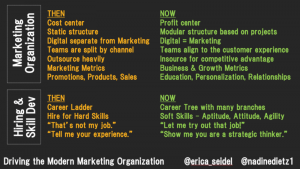In the digital age, B2B companies need to do more than connect with a target audience through marketing; they need to practice integrated digital marketing as part of their business model.
Marketing silos, teams that fail to communicate, collateral that’s hard to find, and a complicated buyer’s journey are common marketing challenges that can crush the momentum of ongoing marketing efforts. It’s time for B2B companies to take a step back and consider:
How can I integrate my digital marketing and create a single, cohesive story across channels and throughout the buyer’s journey?
The answer to this question can be a game changer.
Stop to Consider the Current State of your Digital Marketing Landscape
When you consider all of the individual moving parts within an organization, it’s not surprising marketing efforts are complicated. As a company grows, weak points between creating marketing content and ensuring all teams leverage it effectively becomes more complex, too.
An essential first step in tackling a new strategy for integrated digital marketing is to start at the root level.
Step 1: Develop an Aligned Content Strategy across All Internal Teams
To craft a truly integrated digital marketing strategy requires clarity across all internal teams. Sales, marketing, customer service and more all need to agree on a clear, single narrative of the buyer’s journey, and angle it for their unique customer touchpoint.
In the B2B sales space you need to convert several people within one company, each with a say in the final purchase. Make sure each influencer hears the same key messages to instill clarity, confidence, and reduce friction in the purchase process. Building this single “same team” mentality also keeps communication streaming between internal teams.
Step 2: Define the Buyer’s Journey and Sales Stages
Agreeing to create a single buyer’s journey narrative is a start, but takes time and collaboration to build into a successful integrated digital marketing practice. B2B teams first need to agree on clear definitions for how they see and explain the buyer’s journey, and the specific sales stages customers go through.
Creating a chart to break things down by buyer stage, buyer activity, sales stage and the team responsible can provide a foundation for the unique stages a business’s buyer’s journey. Also review current content to ensure it’s relevant, connects with a specific persona and maps to buyer interests.
Step 3: Create Workflows and Processes that Loop in Internal Stakeholders
If specifics are mapped out in a clear visual way and accessible to everyone, it’s easier to see how steps overlap between teams. This is key to creating a more integrated digital marketing approach and crowdsourcing ideas from the people who interact with customers at all stages of the buyer’s journey.
81% of marketers struggle with collaboration and coordination between content production resources
Clearly define shared goals to get sales, marketing, customer service, internal subject matter experts and field sales reps focused and excited. When teams feel their input is appreciated and valuable, they rally around collaborating in the development of effective content. Executive support is also essential. Remember, when you create a central content repository as a clear hub for input, teams can find documentation easily, which helps fuel engagement.
Step 4: Create a Style Guide and Automate Content Distribution
Once key content pillars ready, decide the how, when, where and why parts of content distribution. Each team is busy focusing on their aspect of the sales pipeline, so creating a style guide makes it easier for teams to deliver consistent content that sticks to a single story arc. A clear guide also shapes a cohesive brand voice in all communication and makes it so easier to automate content without consistent approval loops.
Get clear on the digital channels to automate content distribution; blogs, emails, social media etc. Integrate email campaigns with your marketing automation tool, CRM, and marketing content platform. By aligning email campaigns with the right technology, you get accurate insight into which emails work among target audience segments. Also integrate the CRM platform with your automation system and engage A/B testing to track success of email campaigns based on buyer personas.
Step 5: Close the Loop with Content Optimization
B2B firms in North America spending over $ 5.2 billion a year on content creation efforts alone—that’s 55% of overall marketing budgets. Yet, 50% of B2B enterprise marketers say measuring content effectiveness is a challenge.
Content must be tied to revenue to show real value. Optimizing content for ROI means digging deeper than top-of-funnel reach metrics to measure how content influences a prospect’s decision to buy. It also means getting clear on what content converts and leveraging it in as many ways as possible internally and externally.
Find and clear any content inefficiencies in production and create a content metrics dashboard to measure and optimize shared goals across teams. This will keep people up to date on the health of the content, the production cycle and conversion rates. Then take what you discover and plug it back into planning and strategy.
In short – plan, execute, and optimize as a company-wide team for a truly integrated digital marketing plan.
What practices have helped you integrate your digital marketing?
Digital & Social Articles on Business 2 Community(151)
Report Post




